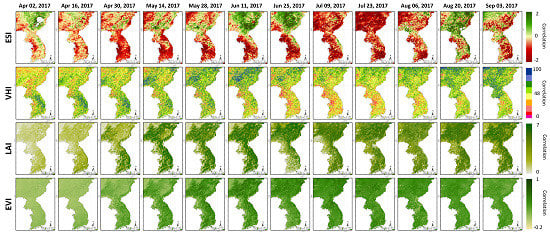Agricultural Drought Assessment in East Asia Using Satellite-Based Indices
Abstract
:1. Introduction
2. Materials and Methods
2.1. Evaporative Stress Index (ESI)
2.2. Vegetation Health Index (VHI)
2.3. Leaf Area Index (LAI)
2.4. Enhanced Vegetation Index (EVI)
2.5. Extreme Drought Events in East Asia
2.6. Drought Analysis Method
3. Results and Discussion
3.1. Analysis of Drought Trends Using Spatial Distribution Maps
3.2. Analysis of Drought Distribution by Region by Extracting Satellite Image Grid Value
4. Conclusions
Author Contributions
Funding
Conflicts of Interest
References
- Sevanto, S. Drought impacts on phloem transport. Curr. Opin. Plant Biol. 2018, 43, 76–81. [Google Scholar] [CrossRef] [PubMed]
- Lott, N.; Ross, T. Tracking and Evaluating U.S. Billion Dollar Weather Disasters, 1980–2005; National Oceanic and Atmospheric Administration’s National Climatic Data Center: Asheville, NC, USA, 2010.
- Tadesse, T.; Brown, J.F.; Hayes, M.J. A new approach for predicting drought-related vegetation stress: Integrating satellite, climate, and biophysical data over the U.S. central plains. ISPRS J. Photogram. Remote Sens. 2005, 59, 244–253. [Google Scholar] [CrossRef]
- Otkin, J.A.; Anderson, M.C.; Hain, C.; Svoboda, M. Examining the relationship between drought development and rapid changes in the Evaporative Stress Index. J. Hydrometeorol. 2014, 15, 938–956. [Google Scholar] [CrossRef]
- Vicente-Serrano, S.M.; Beguería, S.; López-Moreno, J.I. A multi-scalar drought index sensitive to global warming: The Standardized Precipitation Evapotranspiration Index. J. Clim. 2010, 23, 1696–1718. [Google Scholar] [CrossRef] [Green Version]
- Bajgain, R.; Xiao, X.; Wagle, P.; Basara, J.; Zhou, Y. Sensitivity analysis of vegetation indices to drought over two tallgrass prairie sites. ISPRS J. Photogramm. Remote Sens. 2015, 108, 151–161. [Google Scholar] [CrossRef]
- Bajgain, R.; Xiao, X.; Basara, J.; Wagle, P.; Zhou, Y.; Zhang, Y.; Mahan, H. Assessing agricultural drought in summer over Oklahoma Mesonet sites using the water-related vegetation index from MODIS. Int. J. Biometeorol. 2017, 61, 377–390. [Google Scholar] [CrossRef] [Green Version]
- Zhou, Y.; Xiao, X.; Zhang, G.; Wagle, P.; Bajgain, R.; Dong, J.; Jin, C.; Basara, J.B.; Anderson, M.C.; Hain, C.; et al. Quantifying agricultural drought in tallgrass prairie region in the U.S. Southern Great Plains through analysis of a water-related vegetation index from MODIS images. Agric. For. Meteorol. 2017, 246, 111–122. [Google Scholar] [CrossRef]
- Nam, W.H.; Choi, J.Y.; Yoo, S.H.; Engel, B.A. A real-time online drought broadcast system for monitoring soil moisture index. KSCE J. Civ. Eng. 2012, 16, 357–365. [Google Scholar] [CrossRef]
- Nam, W.H.; Hayes, M.J.; Svoboda, M.D.; Tadesse, T.; Wilhite, D.A. Drought hazard assessment in the context of climate change for South Korea. Agric. Water Manag. 2015, 160, 106–117. [Google Scholar] [CrossRef]
- Wilhite, D.A.; Glantz, M.H. Understanding the drought phenomenon: The role of definitions. Water Int. 1985, 10, 111–120. [Google Scholar] [CrossRef] [Green Version]
- Nam, W.H.; Tadesse, T.; Wardlow, B.D.; Hayes, M.J.; Svoboda, M.D.; Hong, E.M.; Pachepsky, Y.A.; Jang, M.W. Developing the vegetation drought response index for South Korea (VegDRI-SKorea) to assess the vegetation condition during drought events. Int. J. Remote Sens. 2018, 39, 1548–1574. [Google Scholar] [CrossRef]
- Svoboda, M.; LeComte, D.; Hayes, M.; Heim, R.; Gleason, K.; Angel, J.; Rippey, B.; Tinker, R.; Palecki, M.; Stooksbury, D.; et al. The drought monitor. Bull. Am. Meteor. Soc. 2002, 83, 1181–1190. [Google Scholar] [CrossRef] [Green Version]
- Groten, S.M.E. NDVI-crop monitoring and early yield assessment of Burkina Faso. Int. J. Remote Sens. 1993, 14, 1495–1515. [Google Scholar] [CrossRef]
- Quarmby, N.A.; Milnes, M.; Hindle, T.L.; Silleos, N. The use of multi-temporal NDVI measurements from AVHRR data for crop yield estimation and prediction. Int. J. Remote Sens. 1993, 14, 199–210. [Google Scholar] [CrossRef]
- Gitelson, A. Remote sensing estimation of crop biophysical characteristics at various scales. In Hyperspectral Remote Sensing of Vegetation; Thenkabail, P.S., Lyon, J.G., Huete, A., Eds.; CRC Press: Boca Raton, FL, USA, 2012. [Google Scholar]
- Berger, A.; Ettlin, G.; Quincke, C.; Rodríguez-Bocca, P. Predicting the normalized difference vegetation index (NDVI) by training a crop growth model with historical data. Comput. Electron Agric. 2018, 1–7. [Google Scholar] [CrossRef]
- Gao, B.C.; Li, R.R. Quantitative improvement in the estimates of NDVI values from remotely sensed data by correcting thin cirrus scattering effects. Remote Sens. Environ. 2000, 74, 494–502. [Google Scholar] [CrossRef]
- Fang, H.; Liang, S.; Hoogenboom, G. Integration of MODIS LAI and vegetation index products with the CSM-CERESMaize model for corn yield estimation. Int. J. Remote Sens. 2011, 32, 1039–1065. [Google Scholar] [CrossRef]
- Kogan, F.N. Application of vegetation index and brightness temperature for drought detection. Adv. Space Res. 1995, 11, 91–100. [Google Scholar] [CrossRef]
- Seiler, R.A.; Kogan, F.; Sullivan, J. AVHRR-Based vegetation and temperature condition indices for drought detection in Argentina. Adv. Space Res. 1998, 21, 481–484. [Google Scholar] [CrossRef]
- Tadesse, T.; Senay, G.B.; Berhan, G.; Regassa, T.; Beyene, S. Evaluating a satellite-based seasonal evapotranspiration product and identifying its relationship with other satellite derived products and crop yield: A case study for Ethiopia. J. Appl. Meteorol. Climatol. 2015, 40, 39–54. [Google Scholar] [CrossRef] [Green Version]
- Wardlow, B.D.; Egbert, S.L.; Kastens, J.H. Analysis of time-series MODIS 250m vegetation index data for crop classification in the U.S. central great plains. Remote Sens. Environ. 2007, 108, 290–310. [Google Scholar] [CrossRef] [Green Version]
- Otkin, J.A.; Anderson, M.C.; Hain, C.; Mladenova, I.E.; Basara, J.B.; Svoboda, M. Examining rapid onset drought development using the thermal infrared–based Evaporative Stress Index. J. Hydrometeorol. 2013, 14, 1057–1074. [Google Scholar] [CrossRef]
- Anderson, M.C.; Hain, C.; Wardlow, B.; Pimstein, A.; Mecikalski, J.R.; Kustas, W.P. Valuation of drought indices based on thermal remote sensing of evapotranspiration over the continental United States. J. Clim. 2011, 24, 2025–2044. [Google Scholar] [CrossRef]
- Allen, R.; Periera, L.; Raes, D.; Smith, M. Crop Evapotranspiration, Guidelines for Computing Crop Water Requirements—FAO Irrigation and Drainage Paper 56; Food and Agricultural Organization of the United Nations: Rome, Italy, 1998. [Google Scholar]
- Anderson, M.C.; Hain, C.R.; Otkin, J.A.; Zhan, X.; Mo, K.C.; Svoboda, M.; Wardlow, B.; Pimstein, A. An intercomparison of drought indicators based on thermal remote sensing and NLDAS-2 simulations with U.S. drought monitor classifications. J. Hydrometeorol. 2013, 14, 1035–1056. [Google Scholar] [CrossRef]
- Anderson, M.C.; Zolin, C.A.; Hain, C.R.; Semmens, K.; Yilmaz, M.T.; Gao, F. Comparison of satellite-derived LAI and precipitation anomalies over Brazil with a thermal infrared-based Evaporative Stress Index for 2003–2013. J. Hydrometeorol. 2015, 526, 287–302. [Google Scholar] [CrossRef] [Green Version]
- Anderson, M.C.; Zolin, C.A.; Sentelhas, P.C.; Hain, C.R.; Semmens, K.; Yilmaz, M.T.; Gao, F.; Otkin, J.A.; Tetrault, R. The Evaporative Stress Index as an indicator of agricultural drought in Brazil: An assessment based on crop yield impacts. Remote Sens. Environ. 2016, 174, 82–99. [Google Scholar] [CrossRef]
- Anderson, M.C.; Norman, J.M.; Mecikalski, J.R.; Otkin, J.A.; Kustas, W.P. A climatological study of evapotranspiration and moisture stress across the continental U.S. based on thermal remote sensing: 1. Model formulation. J. Geophys. Res. Atmos. 2007, 112, D10117. [Google Scholar] [CrossRef]
- Norman, J.M.; Kustas, W.P.; Humes, K.S. A two-source approach for estimating soil and vegetation energy fluxes from observations of directional radiometric surface temperature. Agric. For. Meteor. 1995, 77, 263–293. [Google Scholar] [CrossRef]
- Otkin, J.A.; Zhong, Y.; Lorenz, D.; Anderson, M.C.; Hain, C. Exploring seasonal and regional relationships between the Evaporative Stress Index and surface weather and soil moisture anomalies across the United States. Hydrol. Earth Syst. Sci. 2018, 22, 5373–5386. [Google Scholar] [CrossRef] [Green Version]
- Yang, Y.; Anderson, M.C.; Gao, F.; Wardlow, B.; Hain, C.R.; Otkin, J.A.; Alfieri, J.; Yang, Y.; Sun, L.; Dulaney, W. Field-scale mapping of evaporative stress indicators of crop yield: An application over Mead, NE, USA. Remote Sens. Environ. 2018, 210, 387–402. [Google Scholar] [CrossRef]
- Kogan, F.N. Global drought watch from space. Bull. Am. Meteor. Soc. 1997, 78, 621–636. [Google Scholar] [CrossRef]
- Kogan, F.N. Operational space technology for global vegetation assessment. Bull. Am. Meteor. Soc. 2001, 82, 1949–1964. [Google Scholar] [CrossRef]
- Kogan, F. World droughts in the new millennium from AVHRR-based vegetation health indices. Eos. Trans. Am. Geophys. Union. 2002, 83, 557–563. [Google Scholar] [CrossRef]
- Watson, D.J. Comparative physiological studies in the growth of field crops. I. Variation in net assimilation rate and leaf area between species and varieties, and within and between years. Ann. Bot. 1947, 11, 41–76. [Google Scholar] [CrossRef]
- Chen, J.M.; Black, T.A. Defining leaf-area index for non-flat leaves. Plant Cell Environ. 1992, 15, 421–429. [Google Scholar] [CrossRef]
- Bolstad, P.V.; Gower, S.T. Estimation of leaf area index in fourteen southern Wisconsin forest stands using a portable radiometer. Tree Physiol. 1990, 7, 115–124. [Google Scholar] [CrossRef]
- Smith, N.J. Predicting radiation attenuation in stands of douglas-fir. For. Sci. 1991, 37, 1213–1223. [Google Scholar]
- Myneni, R.B.; Ramakrishna, R.; Nemani, R.R.; Running, S.W. Estimation of global leaf area index and absorbed par using radiative transfer models. IEEE Trans. Geosci. Remote Sens. 1997, 35, 1380–1393. [Google Scholar] [CrossRef] [Green Version]
- Chen, J.M.; Black, T.A.; Adams, R.S. Evaluation of hemispherical photography for determining plant area index and geometry of a forest stand. Agric. For. Meteorol. 1991, 56, 129–143. [Google Scholar] [CrossRef]
- Fassnacht, K.S.; Gower, S.T.; Norman, J.M.; McMurtrie, R.E. A comparison of optical and direct methods for estimating foliage surface area index in forests. Agric. For. Meteorol. 1994, 71, 183–207. [Google Scholar] [CrossRef]
- Stenberg, P.; Linder, S.; Smolander, H.; Flowerellis, J. Performance of the lai-2000 plant canopy analyzer in estimating leaf-area index of some scots pine stands. Tree Physiol. 1994, 14, 981–995. [Google Scholar] [CrossRef] [PubMed]
- Knyazikhin, Y.; Glassy, J.; Privette, J.L.; Tian, Y.; Lotsch, A.; Zhang, Y.; Wang, Y.; Morisette, J.T.; Votava, P.; Myneni, R.B.; et al. MODIS Leaf Area Index (LAI) and Fraction of Photosynthetically Active Radiation Absorbed by Vegetation (FPAR) product (MOD15). Algorithm Theor. Basis Doc. 1999. Available online: https://modis.gsfc.nasa.gov/data/atbd/atbd_mod15.pdf (accessed on 17 December 2019).
- Huete, A.; Didan, K.; van Leeuwen, W.; Miura, T.; Glenn, E. MODIS vegetation indices. In Land Remote Sensing and Global Environmental Change: NASA’s Earth Observing System and the Science of ASTER and MODIS; Springer-Verlag: New York, NY, USA, 2008; pp. 579–602. [Google Scholar]
- Huete, A.; Didan, K.; Miura, T.; Rodriguez, E.P.; Gao, X.; Ferreira, L.G. Overview of the radiometric and biophysical performance of the MODIS vegetation indices. Remote Sens. Environ. 2002, 83, 195–213. [Google Scholar] [CrossRef]
- Rowhani, P.; Linderman, M.; Lambin, E.F. Global interannual variability in terrestrial ecosystems: Sources and spatial distribution using MODIS-derived vegetation indices, social and biophysical factors. Int. J. Remote Sens. 2011, 32, 5393–5411. [Google Scholar] [CrossRef]
- Liu, H.Q.; Huete, A.R. A feedback based modification of the NDVI to minimize canopy background and atmospheric noise. IEEE Geosci. Remote Sens. 1995, 33, 457–465. [Google Scholar] [CrossRef]
- Reed, B.C.; Schwartz, M.D.; Xiao, X. Remote sensing phenology: Status and the way forward. In Phenology of Ecosystem Processes: Applications in Global Change Research; Noormets, A., Ed.; Springer-Verlag: New York, NY, USA, 2009; pp. 231–246. [Google Scholar]
- Mun, Y.S.; Nam, W.H.; Jeon, M.G.; Kim, T.G.; Hong, E.M.; Hayes, M.J.; Tadesse, T. Application of meteorological drought index using Climate Hazards Group InfraRed Precipitation with Station (CHIRPS) based on global satellite-assisted precipitation products in Korea. J. Korean Soc. Agric. Eng. 2019, 61, 1–11. [Google Scholar]
- Deng, G.; Zhang, H.; Guo, X.; Ying, H. Assessment of drought in Democratic People’s Republic of Korea in 2017 using TRMM data. In Proceedings of the 2018 Fifth International Workshop on Earth Observation and Remote Sensing Applications (EORSA), Xi’an, China, 18–20 June 2018. [Google Scholar]
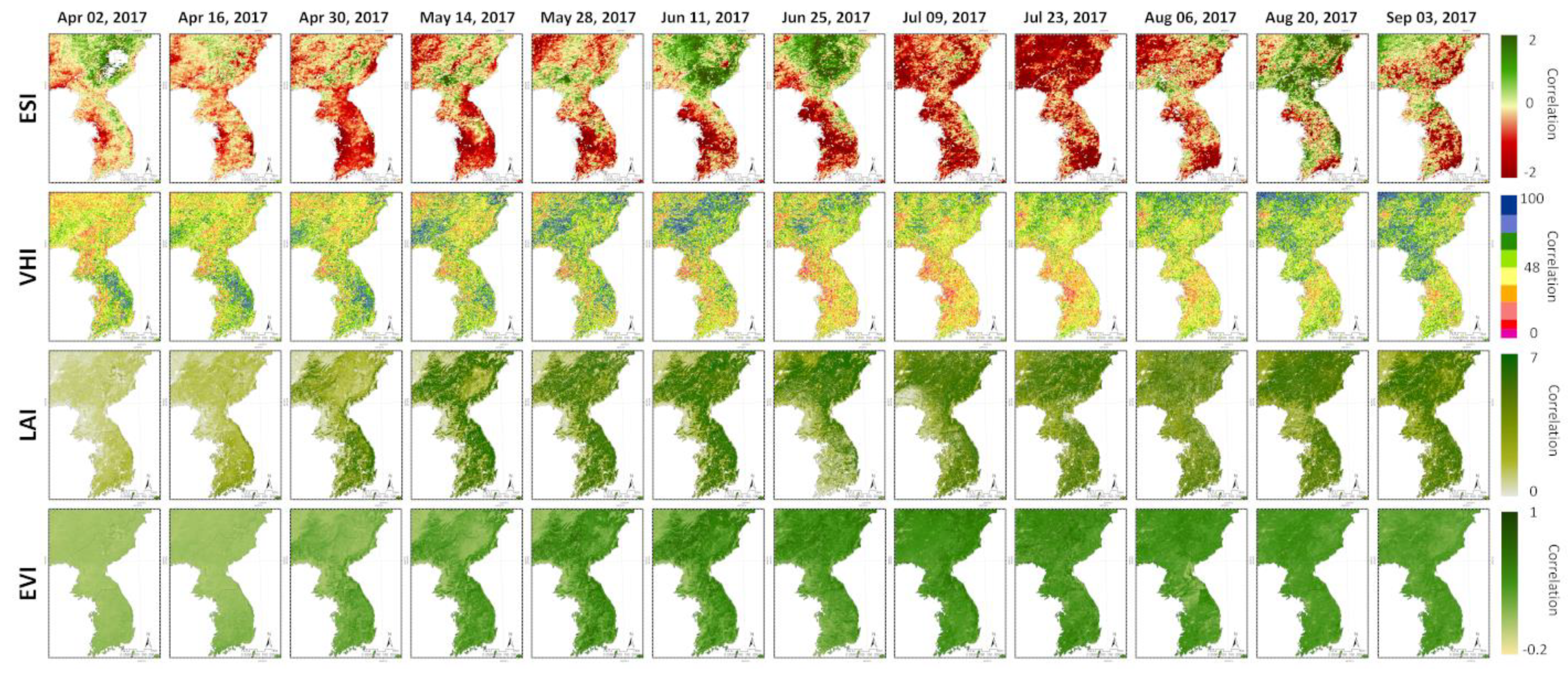
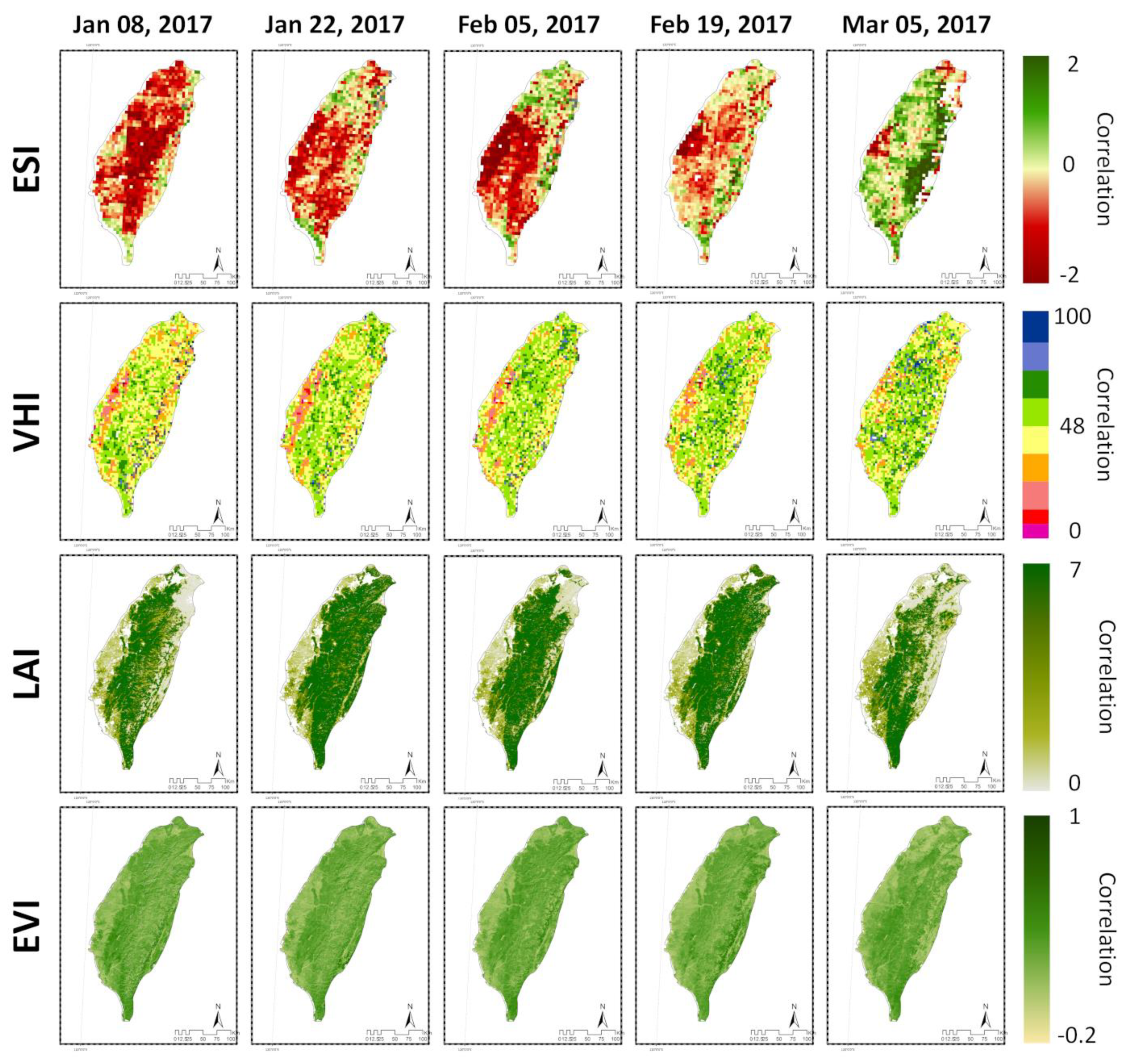
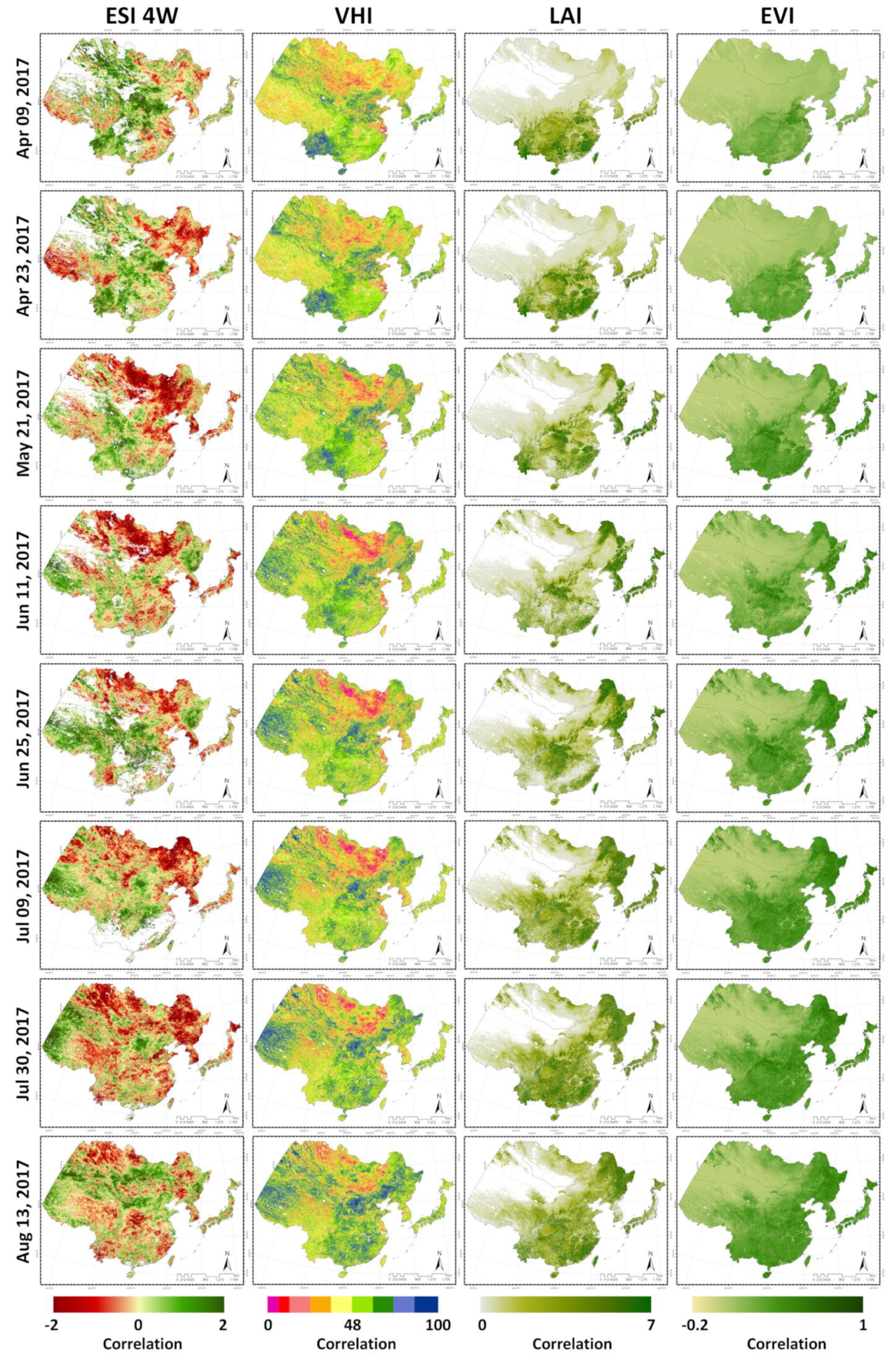

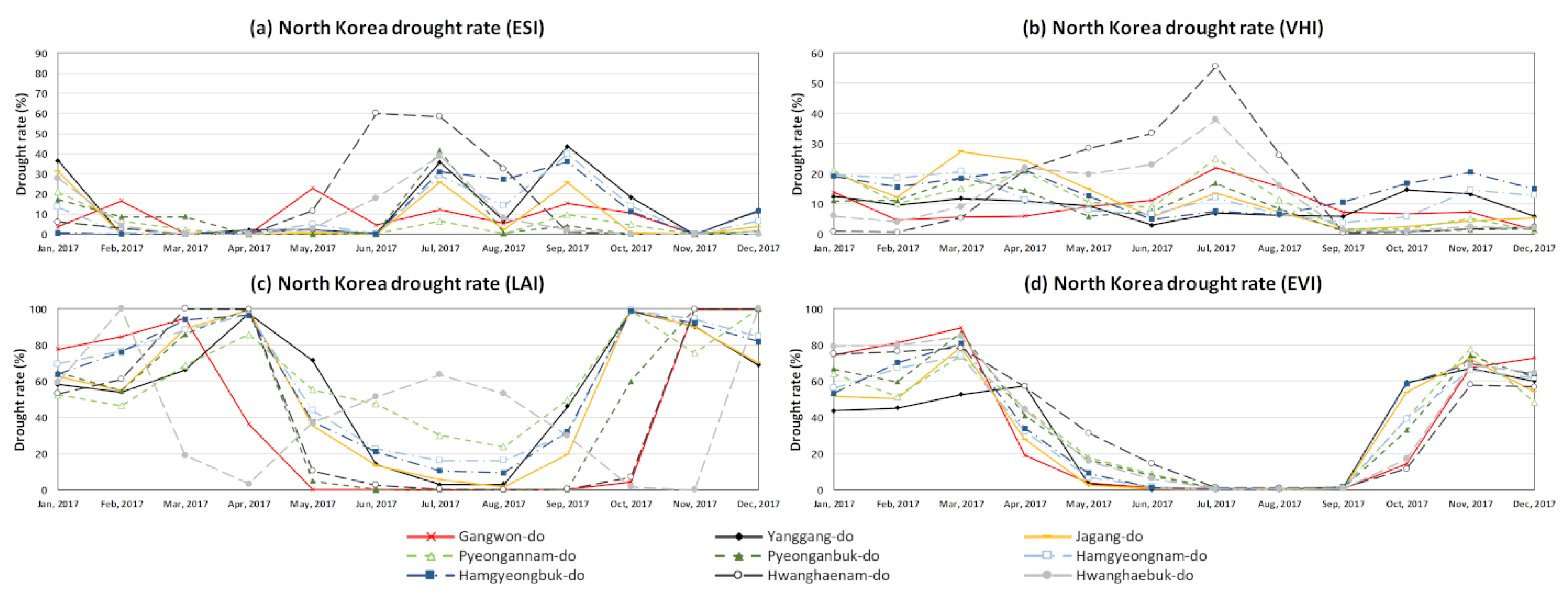

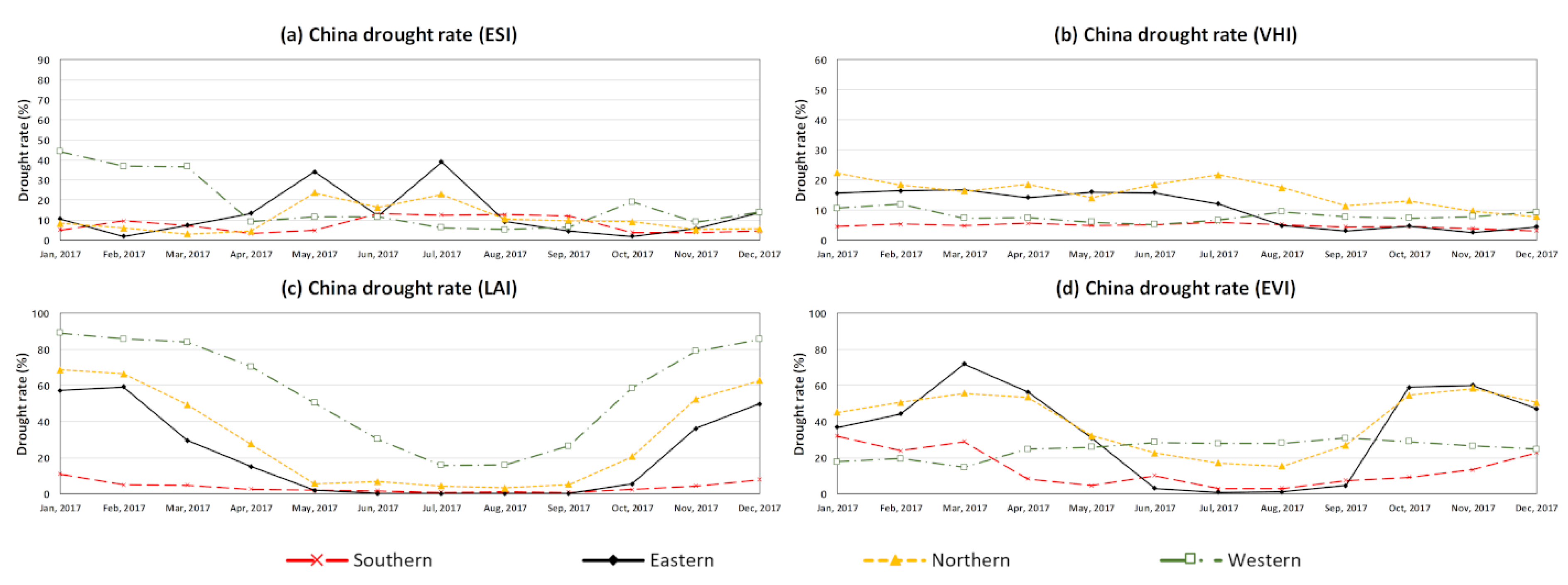
| Country | Drought Period | Drought Area |
|---|---|---|
| South Korea | May, 2017 | Central region (Gyeonggi-do, Jeolla-do, Chungcheong-do) |
| June to July, 2017 | Nationwide | |
| August to September, 2017 | Southern region (Gyeongsang-do) | |
| North Korea | June, 2017 | Southwestern region (Hwanghae-do) |
| August, 2017 | Northeastern region (Hamgyeong-do) | |
| Taiwan | January to February, 2017 | Nationwide |
| China | April to June, 2017 | Northern and Northeastern region |
| Region | Index | Jan | Feb | Mar | Apr | May | Jun | Jul | Aug | Sep | Oct | Nov | Dec |
|---|---|---|---|---|---|---|---|---|---|---|---|---|---|
| Gangwon-do | ESI | 14.3 | 5.1 | 0.0 | 0.0 | 11.1 | 3.2 | 12.0 | 7.5 | 21.2 | 7.1 | 0.0 | 0.5 |
| VHI | 7.0 | 2.9 | 1.7 | 0.9 | 2.1 | 4.6 | 15.0 | 19.3 | 7.3 | 7.8 | 5.1 | 1.5 | |
| LAI | 95.8 | 98.3 | 99.7 | 93.4 | 13.3 | 7.6 | 7.2 | 12.1 | 10.6 | 72.0 | 99.4 | 96.9 | |
| EVI | 55.8 | 61.0 | 61.4 | 5.7 | 1.3 | 0.5 | 0.4 | 0.6 | 0.7 | 5.8 | 39.9 | 54.6 | |
| Gyeonggi-do | ESI | 20.6 | 14.4 | 7.0 | 22.4 | 45.1 | 55.2 | 38.3 | 18.0 | 34.4 | 4.2 | 0.0 | 0.3 |
| VHI | 11.0 | 5.4 | 8.8 | 9.7 | 8.9 | 13.1 | 43.8 | 48.5 | 21.4 | 19.2 | 12.0 | 5.2 | |
| LAI | 65.9 | 82.4 | 92.9 | 97.6 | 49.7 | 43.2 | 37.7 | 40.1 | 46.1 | 75.7 | 94.7 | 76.0 | |
| EVI | 77.1 | 78.4 | 82.5 | 26.7 | 8.3 | 3.8 | 1.4 | 3.4 | 3.8 | 9.5 | 58.4 | 71.5 | |
| Gyeongsang-do | ESI | 1.5 | 2.9 | 0.2 | 1.7 | 20.7 | 28.9 | 63.5 | 36.8 | 61.0 | 26.3 | 0.9 | 0.0 |
| VHI | 4.2 | 4.6 | 6.4 | 3.2 | 2.8 | 9.9 | 19.7 | 10.9 | 7.5 | 13.9 | 11.5 | 4.1 | |
| LAI | 95.8 | 97.1 | 98.0 | 75.6 | 26.1 | 23.3 | 18.9 | 17.7 | 20.8 | 36.5 | 94.2 | 96.6 | |
| EVI | 38.4 | 37.1 | 30.1 | 4.2 | 2.1 | 1.0 | 0.8 | 1.1 | 1.1 | 2.5 | 12.6 | 29.0 | |
| Jeolla-do | ESI | 0.0 | 0.5 | 1.0 | 0.0 | 22.2 | 41.7 | 23.0 | 7.2 | 9.8 | 2.9 | 0.0 | 0.0 |
| VHI | 3.3 | 4.1 | 10.9 | 10.2 | 6.7 | 7.5 | 18.9 | 13.4 | 4.7 | 6.6 | 7.0 | 8.2 | |
| LAI | 95.7 | 98.3 | 98.9 | 86.4 | 43.2 | 41.8 | 24.5 | 17.2 | 31.4 | 49.0 | 96.6 | 95.8 | |
| EVI | 48.6 | 51.5 | 42.3 | 7.6 | 5.2 | 5.9 | 0.5 | 0.7 | 0.8 | 2.4 | 18.8 | 38.3 | |
| Chungcheong-do | ESI | 7.0 | 3.1 | 5.6 | 10.0 | 66.6 | 68.6 | 44.5 | 5.5 | 19.2 | 3.0 | 0.0 | 0.0 |
| VHI | 8.0 | 7.4 | 14.7 | 12.2 | 8.7 | 14.0 | 30.6 | 27.6 | 10.6 | 11.4 | 7.2 | 5.0 | |
| LAI | 85.4 | 95.2 | 98.6 | 97.0 | 42.1 | 38.2 | 29.5 | 22.7 | 33.1 | 62.8 | 98.5 | 91.7 | |
| EVI | 64.7 | 67.6 | 67.5 | 14.5 | 6.1 | 2.9 | 0.7 | 1.0 | 1.2 | 3.3 | 32.7 | 59.4 |
| Region | Index | Jan | Feb | Mar | Apr | May | Jun | Jul | Aug | Sep | Oct | Nov | Dec |
|---|---|---|---|---|---|---|---|---|---|---|---|---|---|
| Gangwon-do | ESI | 3.7 | 16.5 | 0.2 | 0.0 | 22.8 | 4.6 | 12.3 | 5.3 | 15.4 | 10.6 | 0.0 | 0.0 |
| VHI | 13.8 | 4.7 | 5.6 | 6.0 | 9.2 | 11.1 | 21.9 | 15.6 | 7.2 | 6.7 | 7.3 | 1.5 | |
| LAI | 77.7 | 84.4 | 94.9 | 36.4 | 0.1 | 0.0 | 0.0 | 0.0 | 0.0 | 4.4 | 99.5 | 99.7 | |
| EVI | 74.3 | 81.3 | 89.4 | 19.0 | 4.0 | 1.1 | 0.5 | 0.9 | 0.7 | 14.1 | 67.3 | 72.8 | |
| Yanggang-do | ESI | 36.5 | 0.0 | 0.0 | 2.2 | 2.2 | 0.3 | 35.6 | 6.6 | 43.6 | 18.3 | 0.0 | 11.8 |
| VHI | 12.5 | 9.8 | 11.8 | 10.9 | 9.3 | 3.0 | 6.9 | 6.2 | 5.9 | 14.7 | 13.2 | 5.9 | |
| LAI | 58.2 | 54.0 | 66.3 | 97.5 | 71.5 | 13.9 | 2.7 | 2.9 | 45.9 | 98.5 | 90.2 | 68.9 | |
| EVI | 43.7 | 45.2 | 52.5 | 57.5 | 3.2 | 0.3 | 0.2 | 0.2 | 1.5 | 59.3 | 67.2 | 60.0 | |
| Jagang-do | ESI | 31.2 | 0.0 | 0.2 | 0.0 | 0.7 | 0.0 | 25.8 | 2.3 | 25.7 | 0.7 | 0.0 | 3.7 |
| VHI | 20.3 | 12.2 | 27.4 | 24.3 | 15.0 | 5.8 | 13.5 | 7.4 | 1.5 | 2.4 | 4.4 | 5.4 | |
| LAI | 62.4 | 54.8 | 89.1 | 99.1 | 35.5 | 13.4 | 5.6 | 1.7 | 19.5 | 99.7 | 89.7 | 70.2 | |
| EVI | 51.6 | 50.1 | 78.9 | 27.9 | 2.5 | 0.5 | 0.3 | 0.3 | 0.6 | 53.7 | 72.1 | 54.3 | |
| Pyeongan-do | ESI | 19.1 | 7.7 | 5.4 | 0.0 | 0.0 | 0.3 | 24.0 | 0.4 | 6.8 | 2.3 | 0.0 | 1.3 |
| VHI | 16.1 | 10.7 | 16.8 | 17.6 | 8.2 | 8.2 | 20.9 | 9.9 | 1.2 | 1.2 | 3.3 | 1.4 | |
| LAI | 58.6 | 50.5 | 77.2 | 92.9 | 30.1 | 23.8 | 15.0 | 11.9 | 24.9 | 79.5 | 87.7 | 99.9 | |
| EVI | 65.3 | 55.6 | 80.2 | 43.0 | 17.1 | 8.2 | 0.7 | 0.7 | 1.3 | 36.1 | 76.0 | 55.3 | |
| Hamgyeong-do | ESI | 6.9 | 0.2 | 0.0 | 0.6 | 3.5 | 0.1 | 30.1 | 20.6 | 37.9 | 12.6 | 0.0 | 8.9 |
| VHI | 19.4 | 17.1 | 19.7 | 16.3 | 10.3 | 5.8 | 9.8 | 6.6 | 7.2 | 11.3 | 17.5 | 13.9 | |
| LAI | 66.6 | 76.3 | 91.0 | 96.5 | 40.6 | 21.8 | 13.2 | 12.8 | 31.6 | 98.9 | 93.3 | 83.2 | |
| EVI | 54.7 | 68.7 | 77.4 | 33.1 | 7.9 | 1.5 | 0.4 | 0.6 | 1.2 | 48.9 | 67.9 | 62.9 | |
| Hwanghae-do | ESI | 16.9 | 3.5 | 0.0 | 0.0 | 7.3 | 38.9 | 48.6 | 20.1 | 1.6 | 0.0 | 0.0 | 0.0 |
| VHI | 3.4 | 2.3 | 7.2 | 21.6 | 24.2 | 28.2 | 46.7 | 21.1 | 0.9 | 0.9 | 2.1 | 2.2 | |
| LAI | 56.2 | 80.4 | 59.5 | 51.4 | 23.8 | 26.9 | 32.0 | 26.6 | 15.0 | 4.3 | 50.0 | 99.9 | |
| EVI | 77.1 | 78.0 | 81.5 | 50.7 | 23.4 | 10.2 | 0.8 | 0.8 | 0.9 | 14.4 | 63.4 | 60.7 |
| Region | Index | Jan | Feb | Mar | Apr | May | Jun | Jul | Aug | Sep | Oct | Nov | Dec |
|---|---|---|---|---|---|---|---|---|---|---|---|---|---|
| Southern | ESI | 31.5 | 6.6 | 5.6 | 9.2 | 4.7 | 2.8 | 12.0 | 31.0 | 23.1 | 34.7 | 0.3 | 5.4 |
| VHI | 2.9 | 2.1 | 2.4 | 3.3 | 7.0 | 9.5 | 5.7 | 9.7 | 15.3 | 8.4 | 5.4 | 1.9 | |
| LAI | 25.7 | 30.3 | 31.2 | 25.9 | 30.8 | 19.9 | 21.4 | 20.4 | 15.2 | 18.2 | 25.2 | 26.6 | |
| EVI | 7.0 | 7.1 | 5.3 | 4.2 | 4.2 | 3.0 | 3.5 | 3.0 | 3.9 | 3.9 | 3.6 | 6.1 | |
| Eastern and Central | ESI | 49.6 | 6.8 | 2.7 | 0.4 | 7.1 | 10.2 | 13.4 | 23.8 | 43.5 | 68.2 | 0.4 | 2.1 |
| VHI | 3.9 | 1.1 | 0.7 | 1.3 | 13.0 | 33.3 | 17.3 | 8.4 | 7.9 | 5.2 | 6.2 | 6.5 | |
| LAI | 21.5 | 26.3 | 22.9 | 25.3 | 34.4 | 13.4 | 16.6 | 9.3 | 7.9 | 11.6 | 22.2 | 24.7 | |
| EVI | 7.4 | 6.5 | 4.0 | 2.1 | 3.8 | 1.2 | 1.7 | 0.9 | 1.0 | 1.8 | 2.6 | 6.5 | |
| Northern | ESI | 11.5 | 3.5 | 9.4 | 15.5 | 2.1 | 6.2 | 11.1 | 18.5 | 33.5 | 30.0 | 0.4 | 28.7 |
| VHI | 5.6 | 4.0 | 2.9 | 5.8 | 15.9 | 38.0 | 25.3 | 13.7 | 16.8 | 16.2 | 20.4 | 16.1 | |
| LAI | 33.5 | 33.3 | 30.2 | 28.5 | 44.7 | 24.9 | 23.3 | 16.2 | 16.2 | 37.2 | 29.9 | 42.1 | |
| EVI | 10.2 | 11.3 | 13.1 | 5.6 | 10.0 | 4.7 | 4.3 | 4.3 | 5.7 | 13.5 | 7.8 | 10.5 | |
| Western | ESI | 45.9 | 25.3 | 9.1 | 0.0 | 1.4 | 3.2 | 1.4 | 7.1 | 13.5 | 17.6 | 11.5 | 3.7 |
| VHI | 19.5 | 15.7 | 4.0 | 5.6 | 9.6 | 17.9 | 18.6 | 15.9 | 18.1 | 15.1 | 7.8 | 3.2 | |
| LAI | 51.6 | 51.5 | 52.9 | 49.2 | 53.4 | 49.5 | 51.0 | 49.1 | 41.2 | 48.0 | 52.8 | 52.8 | |
| EVI | 16.3 | 21.6 | 11.7 | 4.4 | 4.4 | 3.9 | 11.3 | 4.2 | 5.5 | 5.1 | 6.3 | 11.9 |
| Region | Index | Jan | Feb | Mar | Apr | May | Jun | Jul | Aug | Sep | Oct | Nov | Dec |
|---|---|---|---|---|---|---|---|---|---|---|---|---|---|
| Southern | ESI | 5.0 | 9.7 | 7.3 | 3.3 | 5.0 | 13.2 | 12.6 | 12.8 | 12.0 | 4.0 | 3.8 | 4.5 |
| VHI | 4.6 | 5.4 | 4.8 | 5.7 | 5.0 | 5.2 | 6.0 | 5.3 | 4.4 | 4.6 | 3.9 | 3.1 | |
| LAI | 10.8 | 5.0 | 4.7 | 2.6 | 1.8 | 1.7 | 0.9 | 1.0 | 0.9 | 2.4 | 4.3 | 7.9 | |
| EVI | 31.9 | 23.9 | 29.0 | 8.3 | 4.6 | 10.0 | 2.8 | 3.1 | 7.4 | 9.2 | 13.3 | 22.7 | |
| Eastern | ESI | 10.7 | 1.8 | 7.4 | 13.5 | 34.0 | 12.1 | 39.0 | 9.2 | 4.6 | 1.9 | 5.8 | 13.7 |
| VHI | 15.6 | 16.5 | 16.7 | 14.2 | 16.0 | 15.8 | 12.0 | 4.8 | 3.1 | 4.7 | 2.5 | 4.4 | |
| LAI | 57.3 | 59.3 | 29.5 | 15.1 | 2.0 | 0.2 | 0.1 | 0.1 | 0.2 | 5.5 | 36.2 | 49.8 | |
| EVI | 36.8 | 44.3 | 71.9 | 56.3 | 31.0 | 3.0 | 0.9 | 1.1 | 4.5 | 58.9 | 60.0 | 47.1 | |
| Northern | ESI | 8.4 | 6.0 | 3.1 | 4.5 | 23.7 | 16.3 | 22.8 | 10.6 | 9.8 | 9.3 | 5.3 | 5.6 |
| VHI | 22.4 | 18.4 | 16.3 | 18.5 | 14.0 | 18.6 | 21.6 | 17.4 | 11.4 | 13.1 | 9.7 | 7.8 | |
| LAI | 68.7 | 66.5 | 49.3 | 27.6 | 5.5 | 6.6 | 4.2 | 3.1 | 5.3 | 20.6 | 52.5 | 62.7 | |
| EVI | 45.2 | 50.6 | 55.7 | 53.5 | 32.3 | 22.5 | 17.0 | 15.3 | 27.0 | 54.7 | 58.4 | 50.6 | |
| Western | ESI | 44.2 | 36.9 | 36.7 | 9.2 | 11.5 | 11.6 | 6.3 | 5.2 | 6.6 | 19.0 | 9.1 | 14.1 |
| VHI | 10.7 | 12.0 | 7.4 | 7.5 | 6.1 | 5.2 | 6.7 | 9.5 | 7.7 | 7.3 | 7.8 | 9.4 | |
| LAI | 89.2 | 85.7 | 84.0 | 70.4 | 50.4 | 30.3 | 15.8 | 16.1 | 26.6 | 58.6 | 78.9 | 85.6 | |
| EVI | 17.8 | 19.5 | 14.6 | 24.6 | 25.8 | 28.5 | 27.9 | 28.1 | 30.9 | 29.0 | 26.4 | 24.7 |
© 2020 by the authors. Licensee MDPI, Basel, Switzerland. This article is an open access article distributed under the terms and conditions of the Creative Commons Attribution (CC BY) license (http://creativecommons.org/licenses/by/4.0/).
Share and Cite
Yoon, D.-H.; Nam, W.-H.; Lee, H.-J.; Hong, E.-M.; Feng, S.; Wardlow, B.D.; Tadesse, T.; Svoboda, M.D.; Hayes, M.J.; Kim, D.-E. Agricultural Drought Assessment in East Asia Using Satellite-Based Indices. Remote Sens. 2020, 12, 444. https://doi.org/10.3390/rs12030444
Yoon D-H, Nam W-H, Lee H-J, Hong E-M, Feng S, Wardlow BD, Tadesse T, Svoboda MD, Hayes MJ, Kim D-E. Agricultural Drought Assessment in East Asia Using Satellite-Based Indices. Remote Sensing. 2020; 12(3):444. https://doi.org/10.3390/rs12030444
Chicago/Turabian StyleYoon, Dong-Hyun, Won-Ho Nam, Hee-Jin Lee, Eun-Mi Hong, Song Feng, Brian D. Wardlow, Tsegaye Tadesse, Mark D. Svoboda, Michael J. Hayes, and Dae-Eui Kim. 2020. "Agricultural Drought Assessment in East Asia Using Satellite-Based Indices" Remote Sensing 12, no. 3: 444. https://doi.org/10.3390/rs12030444





